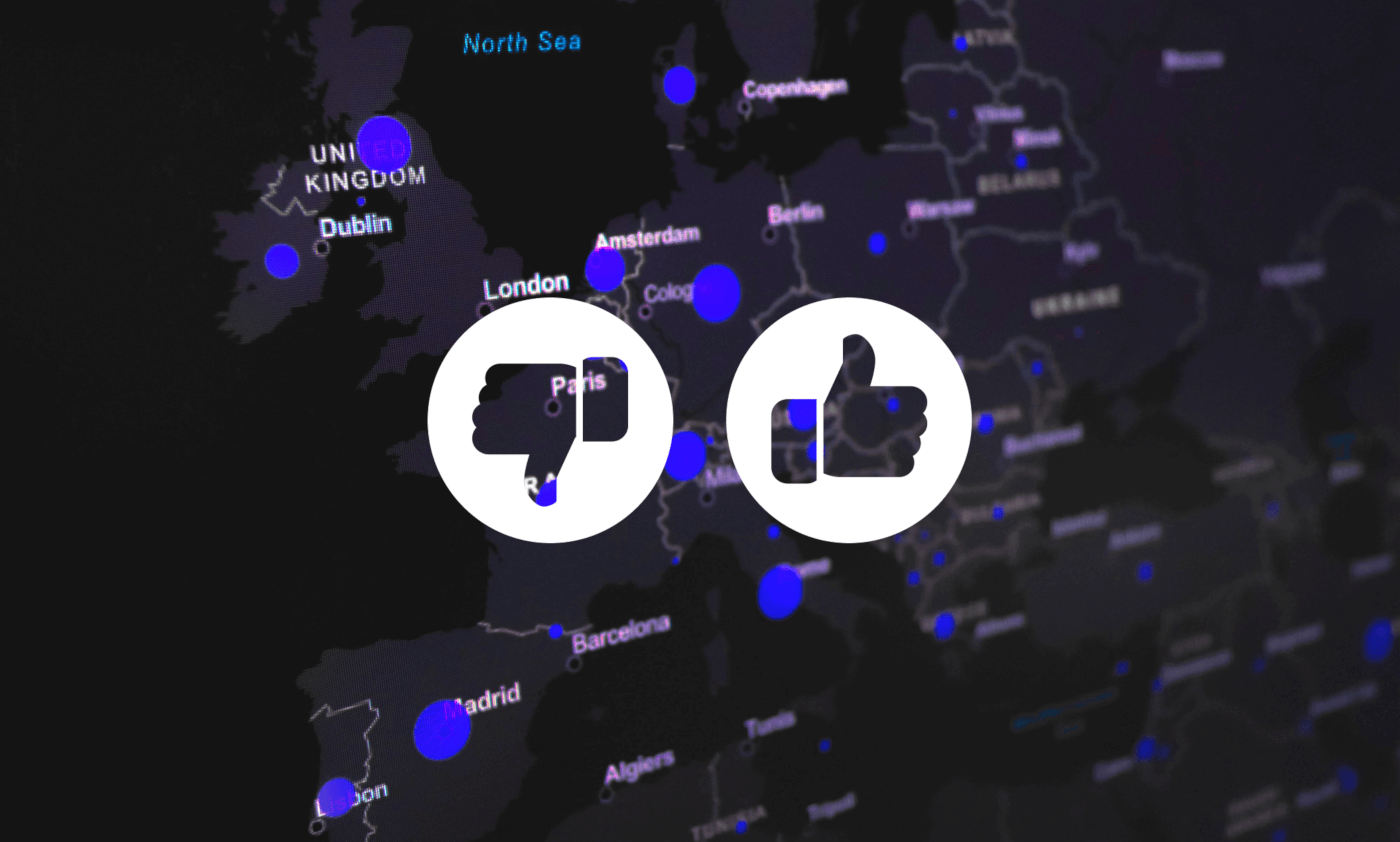The process of constructing an application in 2023 is undeniably thrilling, though it does necessitate comprehensive planning. To ensure the longevity and continued relevance of your software, an excellent starting point is the selection of modern technologies that align seamlessly with your project's objectives and specifications. This strategic choice could be the linchpin in creating enduring and impactful software solutions.
Microservices and serverless are two major concepts in cloud computing as of now. They work well with the efficiency of the application and make changes and scalability much easier and quicker.
Learn more about these microservices and serverless architecture, when to use serverless vs microservice approach, what kinds of software they will fit into, their pros and cons, and their impact on the product overall.
What Are Microservices?
Microservice is a decentralized architecture pattern where an application is broken down into a series of independent functions (services) that can work and communicate together through APIs. Every microservice has its own database, libraries, and templates, and they are tested separately as well.
It is often compared to monolithic architecture. In the latter, all features are one: they are coupled very closely and run as a single function. In microservices, every component is more or less independent and you do not have to run an entire application for one feature.
For example, let’s take music streaming services: profile creation, music search, playlist creation, music playing are all different functions and you can turn them into a series of microservices. If you need a new feature (karaoke mode, for instance), you just create a new microservice and connect it to the rest of the system.
What Is a Serverless Model?
Serverless is a model where the third-party cloud provider takes care of the server themselves. Developers have to worry about the code, and everything else is done by the server provider - security patches, load balancing, capacity management, scaling, logging, and monitoring. You can run either the entire application on a serverless model or a part of it.
The server is being used only when the application is used: as soon as the app code is triggered, the server allocates resources to it and draws them back when the app is no longer active. The app owner pays for the time when the app runs only.
Cloud providers can offer either Backend-as-a-Service (BaaS) or Function-as-a-Service (FaaS). BaaS offers pre-built features so that the developer takes care of the front-end only. It is rarely used since it offers limited control and customization. FaaS, on the contrary, is more flexible: the developers write back- and front-end and just run it on the distant server.
FaaS allows you to build an application as a set of functions. Every function has a purpose and the trigger that activates it. The function is usually short-term and it is deactivated as soon as it is not used anymore – it can not run continuously.
Serverless vs Microservices – Main Differences
The most and foremost difference is that microservices are a way to design an application, while serverless is another way to run an application (or a part of an application). You can host microservices on serverless.
If we compare microservice and serverless function, the difference will be the following:
- Microservices functions can be long-term, continuous, and perform more than one function.
- Serverless functions, on the contrary, are never continuous, need a trigger event, and can not include more than one function.
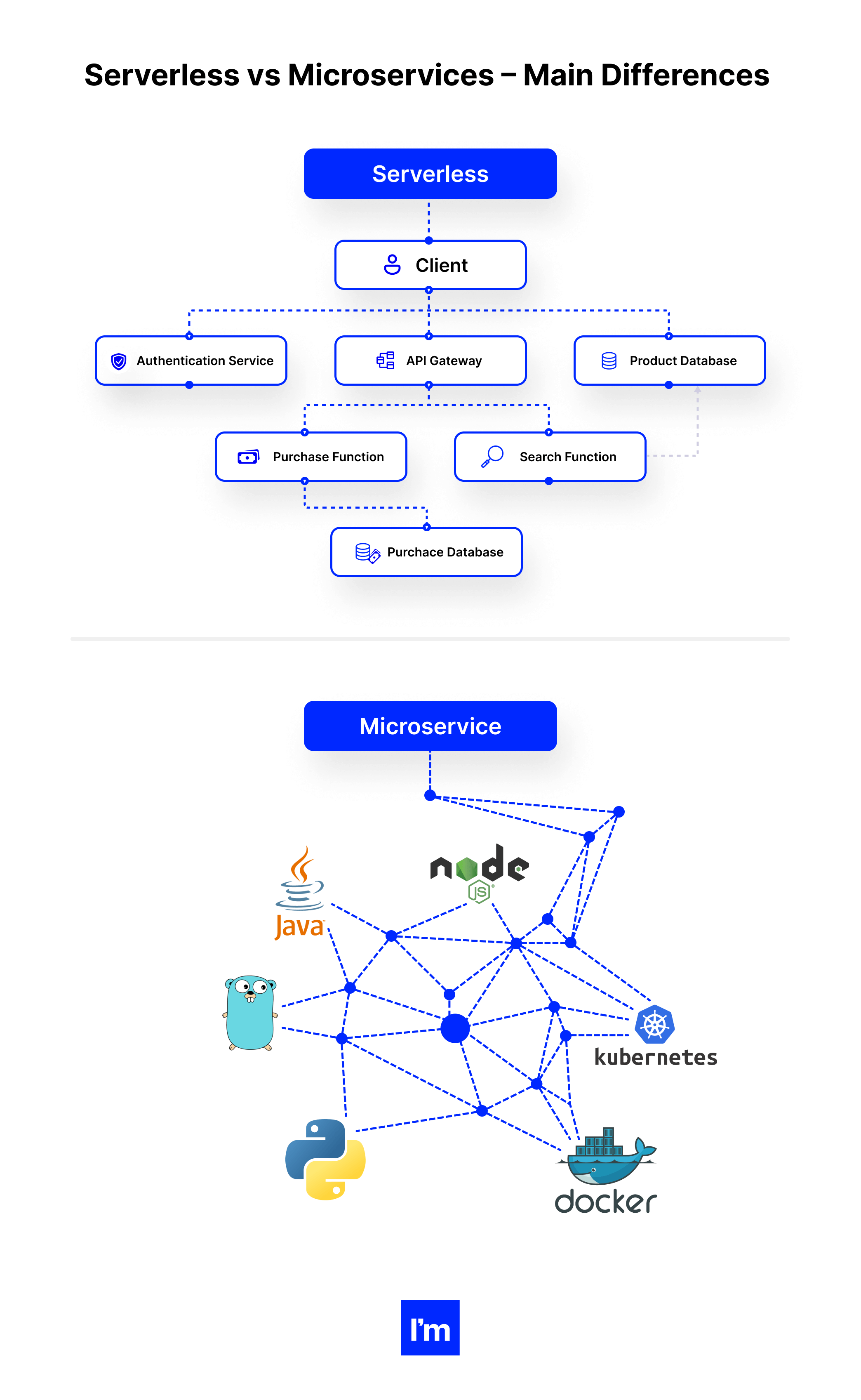
How to Approach Them? What Roles and Resources Are Needed?
When it comes to developing software with microservices, the biggest part is the planning. You will have to figure out what microservices to make and their functions and how they will interact with each other through APIs. You will need a software architect for this.
Regarding the team, you will have to find developers and testers that do actually know microservices. The language and framework do not matter really because microservices can be used in whatever technology you prefer. However, most often microservices are built with the following technologies: JS/TypeScript, Java, .NET, and Python. Experience with data projects and the cloud is usually required for these kinds of projects as well. Developers work better in small, cross-functional teams with microservices.
According to business strategists, the costs of microservices are higher during the development process but cheaper in the long run. If we compare it to a monolithic architecture, the maintenance will cost you less since you can add new functions quicker and with no trouble, and if one microservice is down, the rest of the app will keep running, unlike in the monolith.
The microservice projects usually take less time than monolith because small teams can work on different functions independently at the same time.
If we talk about serverless, you will need to find a good service provider (the most famous being AWS Lambda, Google Cloud Functions, Microsoft Azure Functions, and Cloudflare Workers), choose between BaaS and FaaS, and write down all the functions and their triggers.
As for the development team, you will need to find people who can work with the service provider of your choice and have solid JavaScript or Python skills.
When it comes to the costs of development, it is usually cheaper to host an app or its part on a distant server – that is actually the whole point. The costs of development are much lower than what you are used to.
The quickness of development is also one of the quickest: many companies use this technology exactly to launch their new apps in no time.
When to Use Serverless vs Microservices Architecture?
There is no answer to what is better – microservices or serverless – because each project is its own. Moreover, they can be combined too.
Let’s take a closer look at use cases of both.
Microservices Use Cases
Microservices are widely used by such great enterprises as Netflix, Uber, Airbnb, etc. They allow them to quickly scale and these companies are always growing. As for startups, funding consultants claim it to be not the best idea: the upfront costs are too much and microservices are mostly used for big applications that become difficult to maintain. Small and lightweight apps can be easily maintained as a monolith.
- Apps that need to scale up or down quickly
- Software that you are likely to add new functions to and you will need to do it in a short period of time
- Big data applications: in big data, you have one task at every stage, for example, data collection, processing, delivery, storage, etc., and the point of microservices is to handle particular tasks
- Rewriting legacy applications
- When you have more than one software and need to reuse some of its components
Serverless Use Cases
Serverless is a great opportunity for web and mobile development in startups since they are low-cost and work perfectly with lightweight applications. Enterprises, on the other hand, should be more thoughtful when it comes to serverless since its use cases are limited.
- Software with different traffic: if your app sometimes experiences high spikes of traffic and sometimes it is completely idle, it is a perfect solution since it allocates server resources automatically, based on the current situation. There will be no need to pay for idle time or panic because of traffic spikes.
- Internet of Things: serverless is event-based and so is IoT
- Automate continuous integration and continuous delivery: write down automatic testing or deployment as events and triggers to them
- Anything that contains short-term functions
- Projects that need an immediate start and low costs
Pros and Cons of Serverless vs Microservices Architecture
Unfortunately, there is no one perfect technology – otherwise, the world would have been a happy ultra developed place. Each technology has pros that you can leverage for your project and cons that you need to be ready to tolerate. Let’s take a look at both.
Pros of Microservices
- Easier scalability: you can add or remove functions and scale things with as little effort as possible because the services are independent. You do not have to take into account the entire code base as you would do with monolithic apps
- Better software resilience: since microservices do not depend on each other as much, the fallout of one will not take down the entire app. It is especially useful at times of traffic spikes
- Multilingual: you can write microservices in different languages and connect them with an API. It is a useful benefit since different technologies better correspond to different needs of a feature. If you use too many languages though, you may suffer from different logistics of connecting everything so it is better to keep it simpler
- Different platforms: as well as with languages, you can connect microservices hosted on different platforms. You can also host a part of an app serverless and apart as usual
- Room for experiments: even though we have a lot of data, sometimes our assumptions are not always right – and microservices allow you to test everything. There is no need to pay thousands just to add a new feature that you might want to delete later since apps with microservices are very flexible, as we have already mentioned
- Team autonomy: many small teams can work on the project at once and communicate less with each other
Cons of Microservices
- Difficulties in connection: you have to thoroughly plan how to connect all microservices and transfer data from one place to the other
- Difficult testing: you need to test every microservice independently and then test connectivity on the global scale
- Debugging is complicated: you have to go through logs in every microservice
- Security concerns: you have to pay very close attention to your APIs because they are oftentimes misconfigured and, therefore, vulnerable
Pros of Serverless Model
- Server management is not your problem: you can focus on the application rather than server maintenance
- Effortless scaling: server scales up or down automatically
- Pay-as-you-go: you only pay for the capacity of the server that you use, no need to pay for inactive time
- Very quick deployment: you can quickly develop new features and test your ideas right away
Cons of Serverless Model
- Difficult testing: it is difficult to see how the code will work once deployed because you can not really replicate the serverless environment
- Cold start: after every function is finished, it stays cached but not for long. It means that when you start the function again and it is not cached, it will have to answer the invocation request again which requires some time
- Low flexibility: many people find it difficult to commit to one serverless environment provider for a long time
Real-World Examples
Even though they are relatively new, both technologies have attracted many companies. It is hard to say no to quick development and scaling after all.
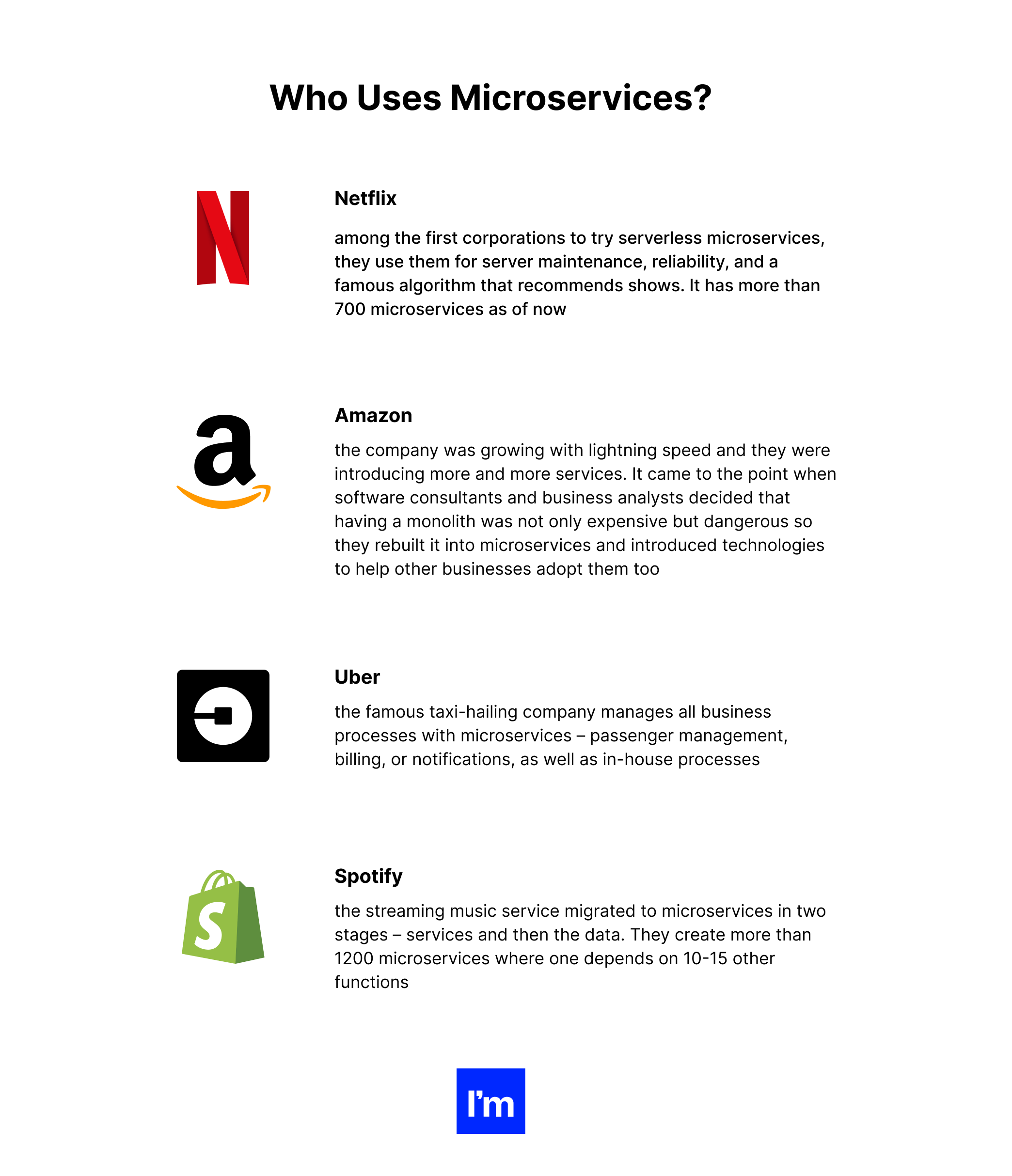
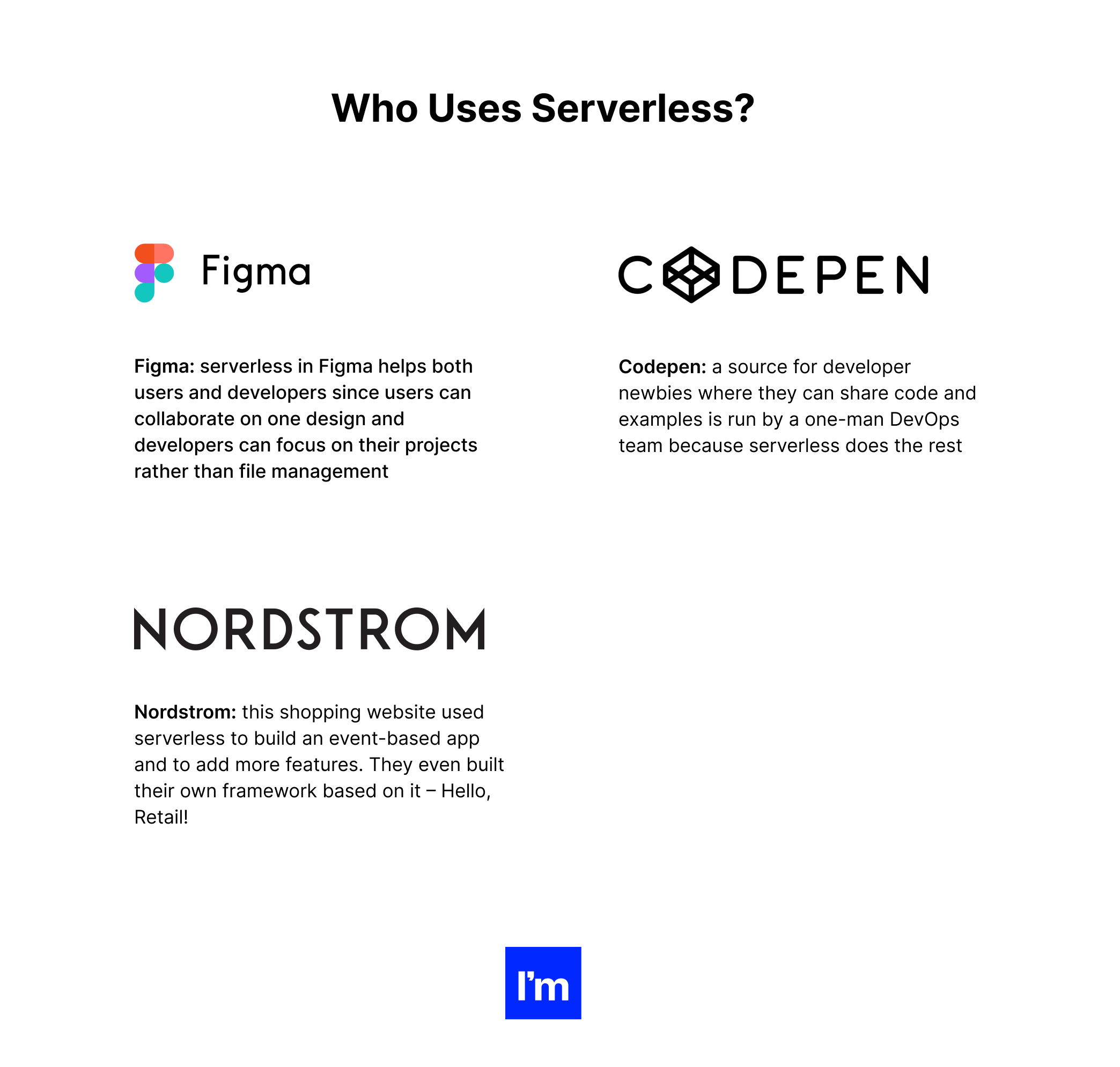
Serverless vs Microservices: Key Takeaways
Serverless and microservices are great technologies if you want to quickly scale, add new features in no time, and reduce costs. You can use serverless for startups and mid-sized companies and microservices will work well for enterprises. If you combine both though, you can use them on the enterprise level as well.
Are you looking forward to building your next application with these two technologies? Do not hesitate to reach out to Ideamotive! We can help you find experienced professionals in serverless and microservices to get you started.
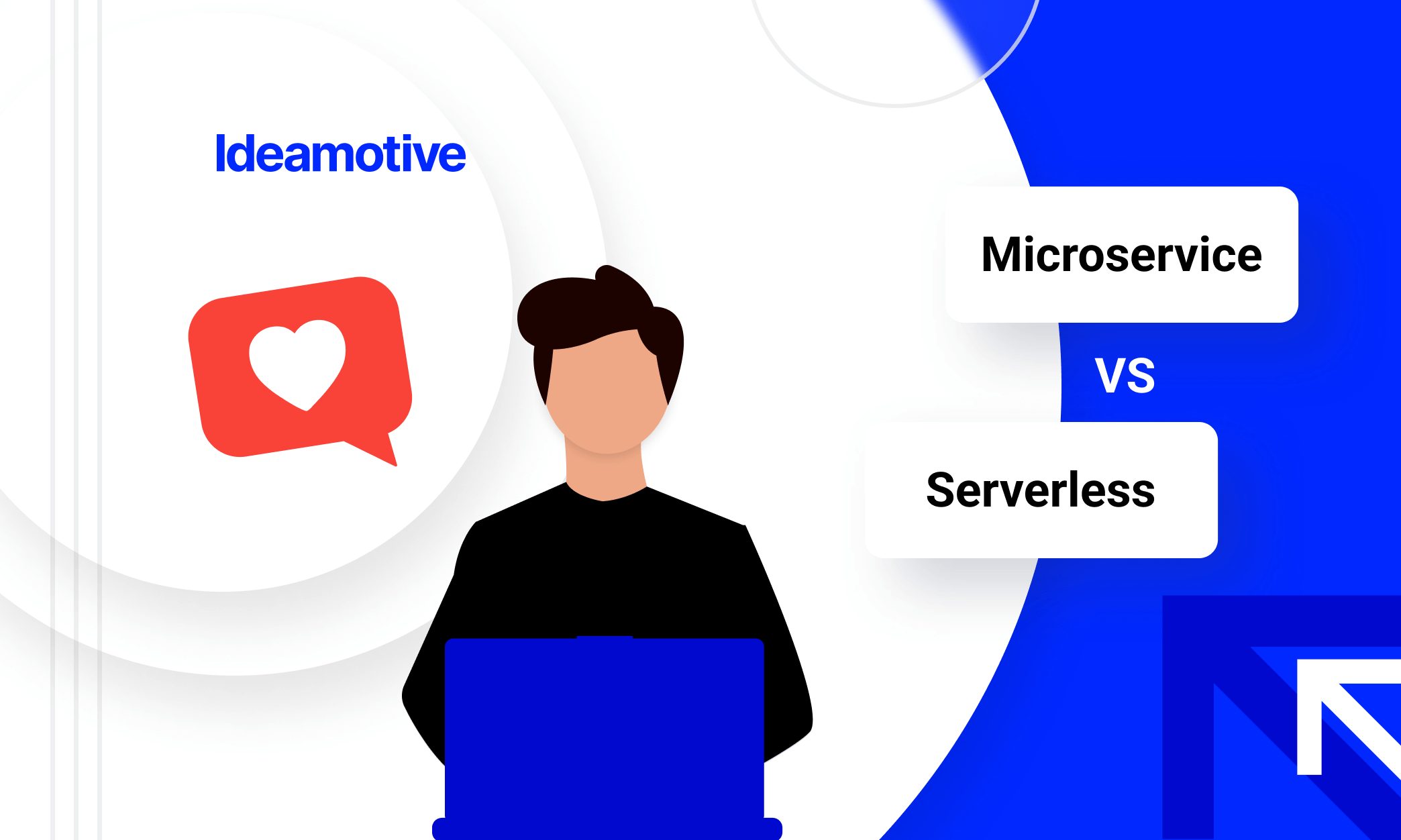





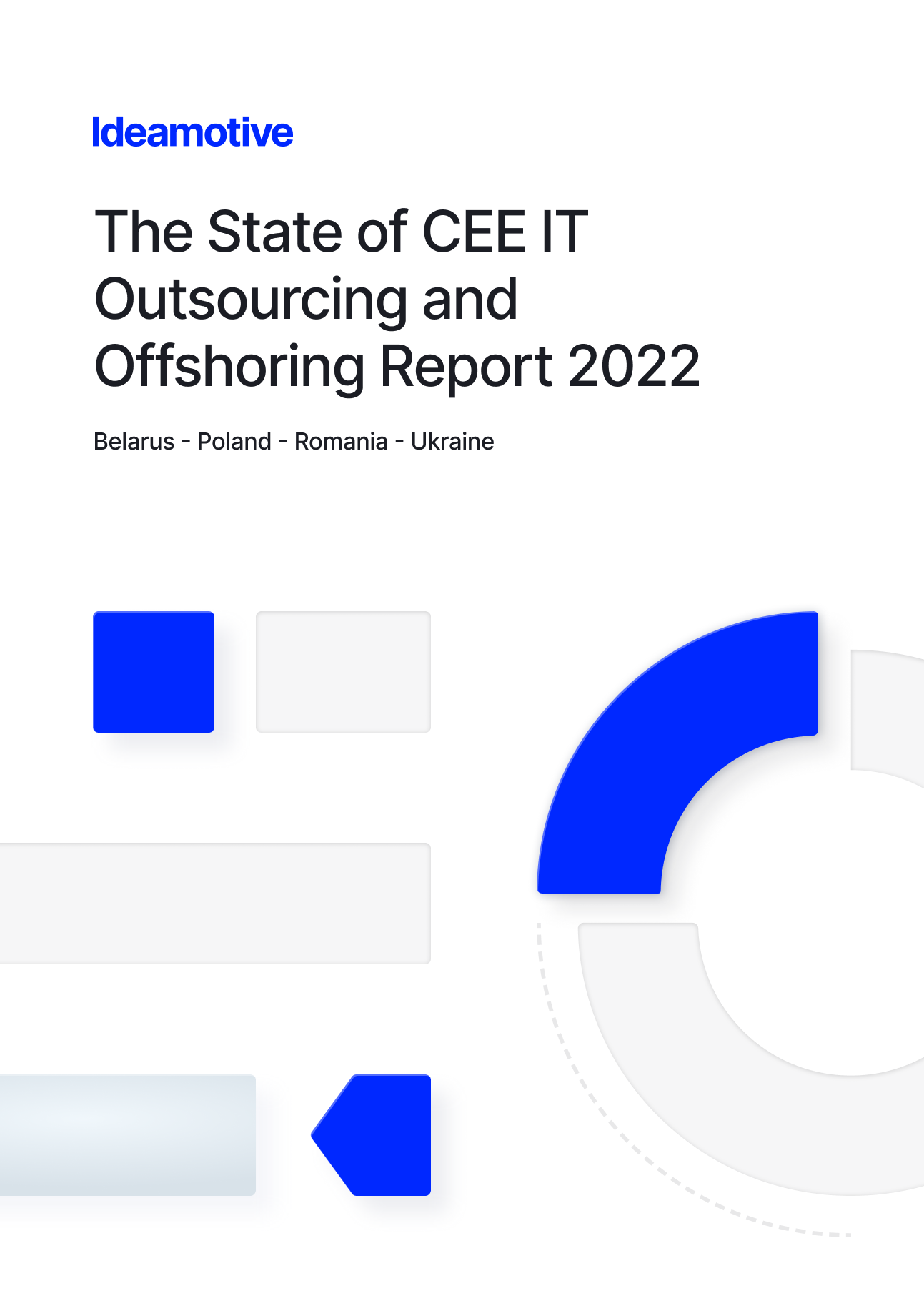
.png)
.png)
